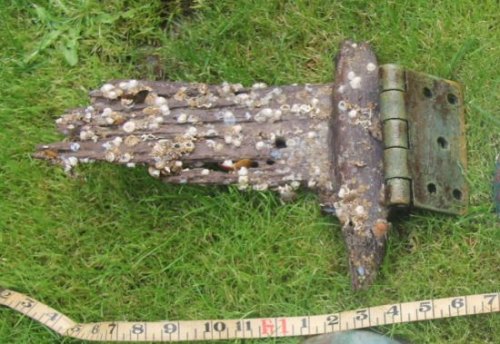
Image use policy
Our images can be used under a CC BY attribution licence (unless stated otherwise).
HINGE
Unique ID: MAS-D100128
Object type certainty: Certain
Workflow
status: Published ![]()
This record refers to the metal hinge and attached timber shown in the top left corner of image one, the other finds are dealt with under separate records.
The object is approximately 305 mm in overall length and 204 mm in overall width. For the hinge element of the object only one leaf can be observed from the photo, which measures approximately 64 mm by 127 mm. Given the leaves are likely to be identical in size, this would suggest the overall width is approximately 127 mm making a regular square when fully opened. The metal of the hinge is in generally good condition, with some blue/green discolouration suggestive of a copper alloy such as brass. The hinge is of a common type known as a butt hinge, with five interlocking knuckles secured through the centre by a pin or pen. The visible leaf bears five holes for affixing the hinge, and it is likely the obscured side bears a similar number. The number of fixing holes suggests a heavy duty use for the hinge, such as a door, rather than use in lighter items such as furniture.
The wooden elements of the hinge are highly degraded and encrusted with barnacles, its function is therefore undiscernible. There does appear to be an element of beading or a baton in wood, immediately attached to the hinge leaf. Protruding from beneath the beading and running away from the hinge is a section of wood with apparently parallel edges, approximately 89 mm wide, that although heavily damaged may represent a narrow plank. This suggests that the moving element of the object, such as a door or hatch, was attached to the obscured leaf, with the other attached to the stationary element such as a door frame.
Butt hinges were manufactured from around 1850 and are one of the most common forms of hinge in use today.
Notes:
These items were found with two bowls (MAS-D100127), two bottles (MAS-D100129), one mug (MAS-D100130), and one copper lid (MAS-D100150).
Class: Fixing
Subsequent actions
Current location of find: With finder
Subsequent action after recording: Submitted as wreck to the Receiver of Wreck
Wreck details
Droit number: 312/17
Chronology
Broad period: NINETEENTH CENTURY
Period from: NINETEENTH CENTURY
Period to: MODERN
Dimensions and weight
Quantity: 1
Length: 305 mm
Width: 204 mm
Discovery dates
Date(s) of discovery: Saturday 30th September 2017
Personal details
Found by: This information is restricted for your login.
Recorded by: P T
Identified by: L R
Other reference numbers
Droit ID: 312/17
Materials and construction
Primary material: Copper alloy
Secondary material: Wood
Completeness: Incomplete
Spatial metadata
References cited
No references cited so far.
Similar objects

Find number: MAS-D100193
Object type: ENGINE
Broadperiod: NINETEENTH CENTURY
Unidentified non-ferrous object that probably represents part of a ships engine or fixtures and fittings. It appears constructed from a copper…
Workflow: Published![]()

Find number: MAS-D100173
Object type: CLOCK
Broadperiod: NINETEENTH CENTURY
This record refers to the clock parts recovered as part of a group of finds. The finder described the items as 6 clock parts, the square glass…
Workflow: Published![]()

Find number: MAS-D100180
Object type: CANNON
Broadperiod: POST MEDIEVAL
This item appears to be a small calibre black powder weapon, such as a swivel gun, commonly mounted on vessels throughout the age of sail as w…
Workflow: Published![]()



